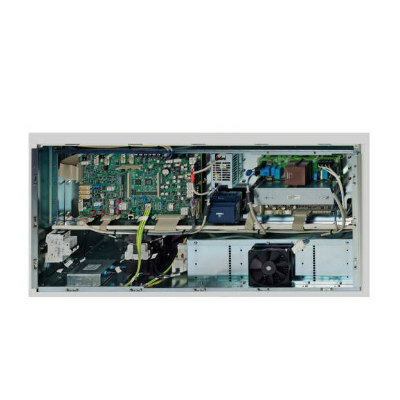AI System Uses Chest X-rays to Accurately Identify Collapsed Lungs
|
By MedImaging International staff writers Posted on 04 Nov 2019 |

Image: An AI-enabled Coral Review would “scan through thousands of existing medical images (i.e., x-rays) for ones similar to a patient’s and recommend a diagnosis to the attending physician” (Photo courtesy of the Vector Institute).
Researchers at the University of Waterloo (Waterloo, Canada) have developed a new assistive technology that can diagnose collapsed lungs, or pneumothorax, from chest X-rays with a higher degree of accuracy than radiologists. The system uses artificial intelligence (AI) software to search a huge database of X-ray images with known diagnoses for comparison to X-rays of new patients with unknown conditions. This approach enables the researchers to identify 75% of cases of collapsed lungs, as compared to medical specialists who diagnose less than 50% of cases using chest X-rays.
The new AI software searches a database of more than 550,000 X-rays, including 30,000 cases of collapsed lungs, for those most similar to a new patient's X-rays. If the known condition in the majority of the similar X-rays is collapsed lung, then the AI recommends collapsed lung as the diagnosis in the new case.
The researchers are working with the University Health Network (UHN), a healthcare and medical research organization consisting of several Toronto-area hospitals, on a project backed by the Vector Institute, a not-for-profit corporation dedicated to advancing AI. The goal is to increase the accuracy of the technology to over 90% and integrate it next year into a software system, Coral Review, developed and used at UHN-affiliated hospitals. Coral, a quality assurance tool, allows doctors to provide second opinions by reviewing medical imaging diagnoses made by their peers. If the AI technology proves to be successful at UHN, then it would be offered to other hospitals, which are currently using Coral.
The system could offer radiologists a "computational second opinion" in Coral, or be used to prioritize the X-rays busy specialists look at first, reducing treatment delays that also put patients at risk. In addition to pneumothorax, the researchers also plan to apply the core AI search system to various other conditions, including pneumonia and chronic obstructive pulmonary disease (COPD), that are diagnosed using chest X-rays.
"Our results are very exciting," said Antonio Sze-To, a postdoctoral fellow at Waterloo. "The AI we use works almost like magic - and it will help radiologists save lives."
"There is no question systems like this will be in place in hospitals within the next two years," said Hamid Tizhoosh, a professor of systems design engineering and director of the Laboratory for Knowledge Inference in Medical Image Analysis (KIMIA Lab). "People are pushing for it and the technology is there."
Related Links:
University of Waterloo
The new AI software searches a database of more than 550,000 X-rays, including 30,000 cases of collapsed lungs, for those most similar to a new patient's X-rays. If the known condition in the majority of the similar X-rays is collapsed lung, then the AI recommends collapsed lung as the diagnosis in the new case.
The researchers are working with the University Health Network (UHN), a healthcare and medical research organization consisting of several Toronto-area hospitals, on a project backed by the Vector Institute, a not-for-profit corporation dedicated to advancing AI. The goal is to increase the accuracy of the technology to over 90% and integrate it next year into a software system, Coral Review, developed and used at UHN-affiliated hospitals. Coral, a quality assurance tool, allows doctors to provide second opinions by reviewing medical imaging diagnoses made by their peers. If the AI technology proves to be successful at UHN, then it would be offered to other hospitals, which are currently using Coral.
The system could offer radiologists a "computational second opinion" in Coral, or be used to prioritize the X-rays busy specialists look at first, reducing treatment delays that also put patients at risk. In addition to pneumothorax, the researchers also plan to apply the core AI search system to various other conditions, including pneumonia and chronic obstructive pulmonary disease (COPD), that are diagnosed using chest X-rays.
"Our results are very exciting," said Antonio Sze-To, a postdoctoral fellow at Waterloo. "The AI we use works almost like magic - and it will help radiologists save lives."
"There is no question systems like this will be in place in hospitals within the next two years," said Hamid Tizhoosh, a professor of systems design engineering and director of the Laboratory for Knowledge Inference in Medical Image Analysis (KIMIA Lab). "People are pushing for it and the technology is there."
Related Links:
University of Waterloo
Latest Industry News News
- Bayer and Google Partner on New AI Product for Radiologists
- Samsung and Bracco Enter Into New Diagnostic Ultrasound Technology Agreement
- IBA Acquires Radcal to Expand Medical Imaging Quality Assurance Offering
- International Societies Suggest Key Considerations for AI Radiology Tools
- Samsung's X-Ray Devices to Be Powered by Lunit AI Solutions for Advanced Chest Screening
- Canon Medical and Olympus Collaborate on Endoscopic Ultrasound Systems
- GE HealthCare Acquires AI Imaging Analysis Company MIM Software
- First Ever International Criteria Lays Foundation for Improved Diagnostic Imaging of Brain Tumors
- RSNA Unveils 10 Most Cited Radiology Studies of 2023
- RSNA 2023 Technical Exhibits to Offer Innovations in AI, 3D Printing and More
- AI Medical Imaging Products to Increase Five-Fold by 2035, Finds Study
- RSNA 2023 Technical Exhibits to Highlight Latest Medical Imaging Innovations
- AI-Powered Technologies to Aid Interpretation of X-Ray and MRI Images for Improved Disease Diagnosis
- Hologic and Bayer Partner to Improve Mammography Imaging
- Global Fixed and Mobile C-Arms Market Driven by Increasing Surgical Procedures
- Global Contrast Enhanced Ultrasound Market Driven by Demand for Early Detection of Chronic Diseases
Channels
Radiography
view channel
Novel Breast Imaging System Proves As Effective As Mammography
Breast cancer remains the most frequently diagnosed cancer among women. It is projected that one in eight women will be diagnosed with breast cancer during her lifetime, and one in 42 women who turn 50... Read more
AI Assistance Improves Breast-Cancer Screening by Reducing False Positives
Radiologists typically detect one case of cancer for every 200 mammograms reviewed. However, these evaluations often result in false positives, leading to unnecessary patient recalls for additional testing,... Read moreMRI
view channel
PET/MRI Improves Diagnostic Accuracy for Prostate Cancer Patients
The Prostate Imaging Reporting and Data System (PI-RADS) is a five-point scale to assess potential prostate cancer in MR images. PI-RADS category 3 which offers an unclear suggestion of clinically significant... Read more
Next Generation MR-Guided Focused Ultrasound Ushers In Future of Incisionless Neurosurgery
Essential tremor, often called familial, idiopathic, or benign tremor, leads to uncontrollable shaking that significantly affects a person’s life. When traditional medications do not alleviate symptoms,... Read more
Two-Part MRI Scan Detects Prostate Cancer More Quickly without Compromising Diagnostic Quality
Prostate cancer ranks as the most prevalent cancer among men. Over the last decade, the introduction of MRI scans has significantly transformed the diagnosis process, marking the most substantial advancement... Read moreUltrasound
view channel
Deep Learning Advances Super-Resolution Ultrasound Imaging
Ultrasound localization microscopy (ULM) is an advanced imaging technique that offers high-resolution visualization of microvascular structures. It employs microbubbles, FDA-approved contrast agents, injected... Read more
Novel Ultrasound-Launched Targeted Nanoparticle Eliminates Biofilm and Bacterial Infection
Biofilms, formed by bacteria aggregating into dense communities for protection against harsh environmental conditions, are a significant contributor to various infectious diseases. Biofilms frequently... Read moreNuclear Medicine
view channel
New SPECT/CT Technique Could Change Imaging Practices and Increase Patient Access
The development of lead-212 (212Pb)-PSMA–based targeted alpha therapy (TAT) is garnering significant interest in treating patients with metastatic castration-resistant prostate cancer. The imaging of 212Pb,... Read moreNew Radiotheranostic System Detects and Treats Ovarian Cancer Noninvasively
Ovarian cancer is the most lethal gynecological cancer, with less than a 30% five-year survival rate for those diagnosed in late stages. Despite surgery and platinum-based chemotherapy being the standard... Read more
AI System Automatically and Reliably Detects Cardiac Amyloidosis Using Scintigraphy Imaging
Cardiac amyloidosis, a condition characterized by the buildup of abnormal protein deposits (amyloids) in the heart muscle, severely affects heart function and can lead to heart failure or death without... Read moreGeneral/Advanced Imaging
view channel
New AI Method Captures Uncertainty in Medical Images
In the field of biomedicine, segmentation is the process of annotating pixels from an important structure in medical images, such as organs or cells. Artificial Intelligence (AI) models are utilized to... Read more.jpg)
CT Coronary Angiography Reduces Need for Invasive Tests to Diagnose Coronary Artery Disease
Coronary artery disease (CAD), one of the leading causes of death worldwide, involves the narrowing of coronary arteries due to atherosclerosis, resulting in insufficient blood flow to the heart muscle.... Read more
Novel Blood Test Could Reduce Need for PET Imaging of Patients with Alzheimer’s
Alzheimer's disease (AD), a condition marked by cognitive decline and the presence of beta-amyloid (Aβ) plaques and neurofibrillary tangles in the brain, poses diagnostic challenges. Amyloid positron emission... Read more.jpg)
CT-Based Deep Learning Algorithm Accurately Differentiates Benign From Malignant Vertebral Fractures
The rise in the aging population is expected to result in a corresponding increase in the prevalence of vertebral fractures which can cause back pain or neurologic compromise, leading to impaired function... Read moreImaging IT
view channel
New Google Cloud Medical Imaging Suite Makes Imaging Healthcare Data More Accessible
Medical imaging is a critical tool used to diagnose patients, and there are billions of medical images scanned globally each year. Imaging data accounts for about 90% of all healthcare data1 and, until... Read more



















